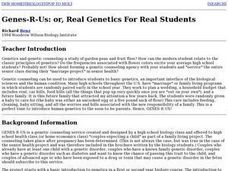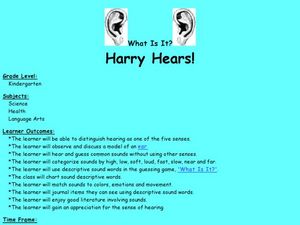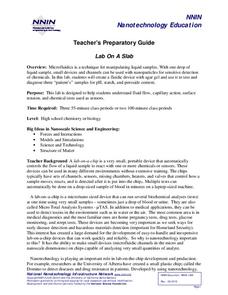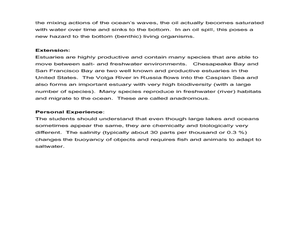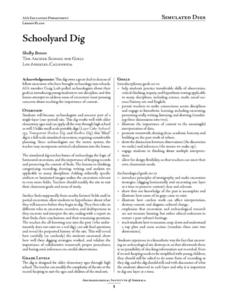Curated OER
Apoptosis: Programmed Cell Death During Development
Young scholars model the plasticity of neural pathways for memory in the brain. They simulate the cell activity according to dots on cards that they are given. They complete various simulations of different cell combinations.
Curated OER
Punting and Projectile Motion
Students explore the concept of projectile motion. In this physics lesson, students watch the video "Science of NFL Football – Projectile Motion and Parabolas." Students participate in computer simulations on the range of projectiles...
Curated OER
What Do Trees Do for Dinner?
Students investigate how trees produce their own food. They examine chlorophyll cells with a microscope, analyze a cross section of a log, determine how old the tree was, simulate the distance of the roots, and create a play.
Curated OER
Genes-R-Us: or, Real Genetics For Real Students
Students explore genetics and genetic counseling. They research information on human genetic disorders. Students simulate developing a complete counseling service to assist the community.
Curated OER
Harry Hears!
Students explore ear anatomy and the sense of hearing. In this hearing lesson plan, students discuss the five senses and view a model of an ear. Students place cotton balls in their ears to simulate loss of hearing. Students use...
University of Southern Indiana
Manifest Density
There's a lot content packed into the four lessons of this physical science unit on density. From salad dressing to the water cycle and hot air balloons, these lessons engage students in hands-on activities that explore real-world...
Columbus City Schools
It’s All Relative
Are the people on the other side of the world standing upside down? Pupils discuss the relationship between movement and position words. The unit explores the concept of reference points through animation, modeling, photography, and...
Columbus City Schools
It's the Heat and the Pressure?
Ready for a change? Give a comprehensive collection of metamorphic materials a try! With the assortment of printables and lab activities, you won't be under pressure to keep things lively. The unit culminates by having...
National Nanotechnology Infrastructure Network
Lab On A Slab
Capillary action is the frugal chemist's dream ... the less liquid used, the more tests they can run! Learners experiment with the best design to maximize the benefits of capillary action. Using a liquid sample, they design a capillary...
Serendip
Evolution and Adaptations
Survival of the fittest isn't just for the movies! A five-part lesson explores several different species with known adaptations and analyzes them for their survival strategies. Using both video and research data, scholars draw...
Mathematics Vision Project
Module 7: Modeling with Functions
The sky's the limit of what you create when combining functions! The module begins with a review of transformations of parent functions and then moves to combining different function types using addition, subtraction, and...
National Wildlife Federation
The Amazing Adventures of Carbon: How Carbon Cycles through the Earth
Here's a stat for your pupils: 18 percent of the human body is carbon! Part 10 in the series of 12 takes pairs on an adventure through the carbon cycle. After a class reading about carbon, pairs read and choose their own adventure...
Berkeley Lab
Virtual Frog Dissection Kit
Fluffy is one of the most common names for a pet frog. Fluffy, the digitized frog in this dissection kit, opens up quite literally to allow scholars to see what's inside. The basic kit encourages pupils to click on various organs to see...
Curated OER
The Greek Gods
What were the early Greek myths? Have elementary students examine the Persian Wars and read various Greek myth in order to identify the cause and the results of the Persian Wars. Myths, activities, simulations, and a unit plan are links...
Curated OER
Making New Electricity
Pupils investigate the concepts of energy conversion and conservation. They research the history of energy conversions into electrical energy. They design experiments in order to replicate a conversion of energy into electricity.
Curated OER
Simulated Underground Railroad Experience
Learners participate in a unit that focuses on the Underground Railroad of the Civil War Period of History. The intent of the unit is realized in the culminating activity of going to many different stations to interact for different...
Curated OER
India and Pakistan: a Simulation of Outcomes
Students become aware of world conflicts and how conflict resolution is used to minimize threats around the world. They analyze a current world conflict and utilize conflict resolution strategies to determine a viable peace initiative.
Curated OER
The Effects of Environment on Plant Growth: Selecting Seeds for Survival on a New Planet
Fifth graders conduct experiments to compare seed germination and plant growth rates. They construct a hydroponic plant unit and a lighthouse. They care for the plants for a month and collect data for graphs. They write a report.
Curated OER
Teacher's Guide For: Water Temperature and Salinity Experiment
Students experiment with water density, temperature and salinity. In this water instructional activity, students observe how the coldest water sinks to the bottom of a test tube, and how saltwater sinks in comparison to freshwater.
Curated OER
How Banks Create Money
Students participate in a simulation game to discover the role of banks in creating checkbook money through lending practices. They play a lending and borrowing game and use a money multipiler equation to solve problems associated with...
Curated OER
WORKING WITH WORKBOOKS
Students work through problems in the textbook and teacher-made problems to reinforce the new learning. They turn in practice problems to instructor to be checked for accuracy and evidence of understanding
Curated OER
Schoolyard Dig
Students begin the lesson by being introduced to the new vocabulary associated with archaeology. In groups, they use the school grounds to simulate their dig site. They record all the objects they discover and what can be gathered from...
Curated OER
Advanced Information Systems Database Access
Students investigate the usage of databases. They design and create their own databases to hold information. They edit the file and sort/ index the new database. They also generate a detailed report of the data present.
Curated OER
Introduction to the Holocaust
Eighth graders examine the implications of the Holocaust. In this human justice lesson, 8th graders unknowingly participate in a segregation simulation and discuss its outcome. Students compare the simulation to the discrimination that...





